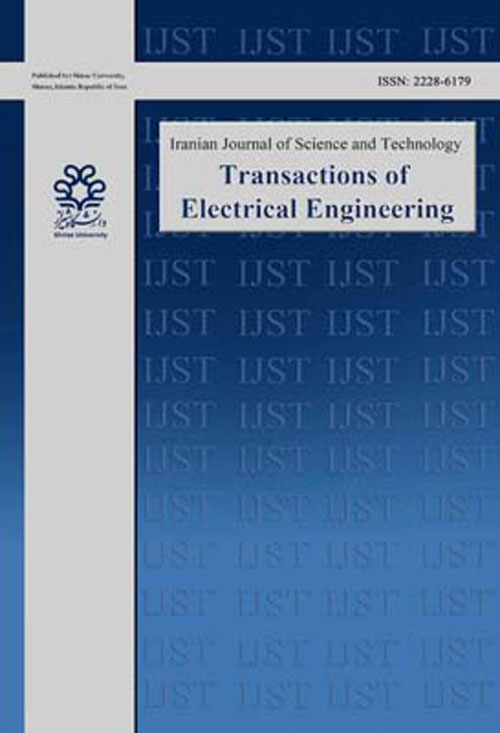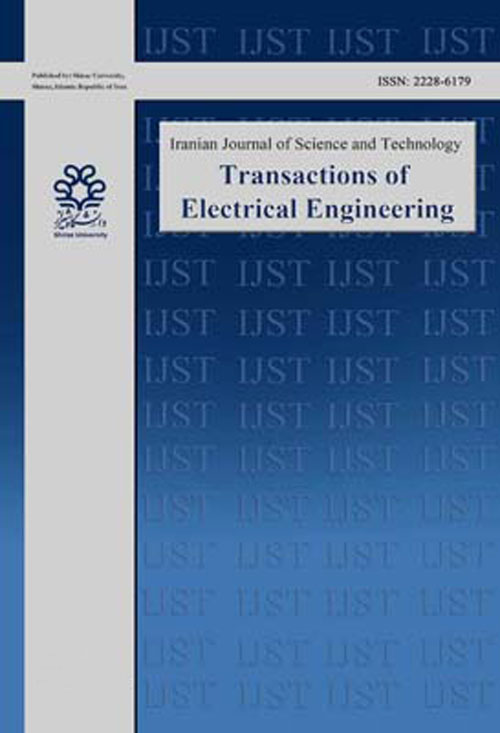فهرست مطالب

Iranian Journal of Science and Technology Transactions of Electrical Engineering
Volume:39 Issue: 1, 2015
- تاریخ انتشار: 1394/03/24
- تعداد عناوین: 8
-
-
Pages 1-21In this paper the problem of minimizing the total transmitting power subject to a fixed total bit rate in OFDM systems is considered. Upper bounds on transmitting power and bit rate of each subcarrier can also be taken into account. In practice, the number of bits of each subcarrier should be integer and nonnegative. In this paper an analytical optimal solution is derived for the case of assuming the bits to be integer. Then, the solution is extended for the case of nonnegative integer bits and the cases in which we have constraints on the maximum power and bit rate of each subcarrier. In an OFDM system with N subcarriers the complexity of computing the proposed analytical solution is O(N) which is lower than the computational complexity of existing algorithms. In addition to the mathematical proofs, computer simulations confirm that the proposed analytical solution is optimal and faster than the existing algorithms.Keywords: Optimum bit loading, discrete multi, tone (DMT) modulation, discrete optimization, orthogonal frequency division multiplexing (OFDM)
-
Pages 23-37Recently many studies have been done on different issues of using multiple antennas at transmit and receive sides of a radar system in a MIMO (Multiple Input Multiple Output) configuration. In addition, for the electronic warfare‟s purposes, the utilization of available signals of the environment to detect the targets has gained considerable attention in recent years. Such passive radars use the transmitter of other purposes (e.g. the GSM or television stations) as their noncooperative transmitter. Moreover, the idea of using multiple of such illuminators to get the advantages of MIMO technology, besides the advantages of passive illumination, is new and attractive. An excellent candidate of such configuration is a DVB-T SFN (single frequency network). However, various obstacles and considerations appear when working with a MIMO DVB-T based passive radar system. In this paper, we consider two such problems: tracking multiple targets and choosing appropriate positions for the receive antennas in the surveillance region. First, based on the previously developed schemes to associate the receive data to the transmitters and targets, we propose a tracking algorithm to extract the true targets from the candidate targets. Then, we develop a procedure to place the receivers of such MIMO passive systems in such positions that result in better performance of the aforementioned association algorithm.Keywords: MIMO, PCL, geometry optimization, receiver placement, tracking
-
Pages 39-54In this paper, a new method is investigated for model order reduction of high order systems based on moment matching technique. In this method, at first, full order model is expanded by Legendre wavelet function which is included in orthogonal functions. A suitable fixed structure model is considered as reduced order model whose parameters are unknown. These unknown parameters are determined using Harmony Search (HS) algorithm by minimizing the errors between the l first coefficients of Legendre wavelet expansion of full and reduced systems. The Routh criterion is applied for specifying the stability conditions. Therefore, the stability condition is considered as constraints in optimization problem. To present the ability of the proposed method, four test systems are introduced. The obtained results are compared with other conventional techniques such as Balanced Truncation (BT) method and Hankel Singular Value (HSV) method. The obtained results show the proposed approach performs very well with respect to other reduction methods.Keywords: Model reduction, moment matching, legendre wavelet, harmony search algorithm, Routh array
-
Pages 55-66In this paper, the problem of finite time stabilization for guidance system is investigated and a novel nonlinear guidance law against maneuvering targets is proposed based on the principles of parallel navigation. The proposed law is developed using two variable structure control techniques. By applying finite time integral sliding mode and combining it with terminal sliding mode, a new guidance law with finite time convergence is designed. It is demonstrated that the proposed law is able to drive the line-of-sight (LOS) angular rate to the origin in finite time, before the final time of guidance process. Due to their crucial importance, the autopilot dynamics are taken into account and finite time stability of the guidance system is guaranteed in spite of the autopilot dynamics. Furthermore, in practice, it is desirable that the target acceleration be regarded as an unknown bounded disturbance. Since the proposed law is robust against target maneuvers, the exact measurement or estimation of the target acceleration is not required. Three-dimensional simulation results verify the robustness and usefulness of the proposed technique.Keywords: Finite time guidance law, autopilot dynamics, variable structure control, proportional navigation
-
Pages 67-77Lunar and Mars landing is a crucial part of any exploration mission. Its importance is manifested by the considerable interest in the past couple of decades. Solution of lunar descent can be either numerical or analytical. Numerical solutions are iterative and computationally demanding and some of them might not be suitable for on-board implementation. On the other hand, analytical solutions are not complex and are much more attractive for the same purposes. All the present analytical solutions schemes are two dimensional considering only altitude and down range to describe the reference trajectories of a lunar descent. The main contribution of this paper is the development of 3-dimensional analytical solution for the reference trajectory which is crucial for a precise landing of a lunar spacecraft. In this investigation cross range distance is incorporated for complete representation. Comparisons are made by simulated responses between numerical and analytical solutions. Detailed mathematical derivations are presented in this paper as well.Keywords: Lunar descent, numerical solution, analytical solution, 3, D modeling
-
Pages 79-91In this paper, sufficient conditions are proposed to investigate the robust stability of arbitrary switched linear systems with uncertain parameters belongs to the known intervals. In addition, a method is then established to determine the maximum intervals of parameter's variations which guarantee robust exponential stability of uncertain switched linear systems under arbitrary switching. In the proposed method, the known information about the parametric structure of uncertainties is considered; therefore it will result in less conservative stability margins. A generalization of the method is also provided to determine stability bounds on perturbations of entries in subsystem matrices, when subsystems are subjected to independent perturbations. Numerical examples are included to illustrate the effectiveness of the results, and compare them with the previous results. It is shown that the proposed methods provide stability intervals on the uncertain parameter for all switched linear systems which admit a common quadratic Lyapunov function for the nominal system.Keywords: Switched linear system, exponential stability, parametric uncertainty, arbitrary switching signal
-
Pages 93-100Designing a power splitter with five ports has been shown in this article. In order to prevent the direct coupling between waveguides, a T-shaped structure with an appropriate distance has been used. The coupling between the parallel photonic crystal waveguides is based on multimode interference, while selecting the output efficiency is performed by setting the refractive coefficients and radius of cavities in the coupling area. The photonic crystal of the splitter has a square-shaped structure made of silicon rods with lattice constant “a”, radius of 0.2a and linear refractive index of n=3.4. The filling factor of this structure is r/a=0.18. Characteristic curve of the power splitter has been simulated by means of finite difference time domain (FDTD) method. The present device can be used in the future photonic integrated circuits and optical network applications.Keywords: Photonic crystal, power splitter, coupling area, finite difference time domain (FDTD)
-
Pages 101-113Modeling is one of the most interesting areas in various fields of science. Unfortunately data quality, which has an important role in the modeling, is not considered. In fact, most often processes encounter disturbances which results in the collection of abnormal data and may lead to a model different from the real behavior of the process. On the other hand, most of real industrial processes are time varying and developing on-line models to capture the variations of the process is very appealing. High capability of intelligent models has attracted considerable attention. Therefore, on-line intelligent models can effectively characterize both time invariant and time varying processes. Current on-line modeling techniques adapts the primarily identified process model with the new changes in time varying processes without consideration of abnormal situations. This will affect the model. To overcome this problem, this paper proposes to combine process monitoring techniques with modeling approaches. Although the proposed approach is not restricted to a specific process monitoring or modeling approach, wave-net on-line techniques and recursive principal component analysis (RPCA) methods are invoked. A double continuously stirred tank reactor (CSTR) is considered as a case study. The results show the effectiveness of the proposed approach.Keywords: On, line model improvement, wave, net learning, process monitoring, data quality


